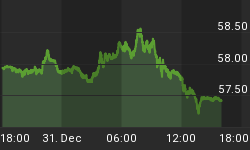Gold jumped up on the eve of the U.S. election. It seemed to be looking beyond... and indeed it was. Gold continued rising as the attention then turned to the fiscal cliff and escalating tensions in the Middle East.
The markets have been focusing on the next major problem. The fiscal cliff will surely help keep the markets volatile. But the ongoing uncertainty and the historical money pumping will continue to be dominant factors affecting the markets.
Gold sees inflation coming. With the Fed's ongoing record stimulus, for example, it sees uncertainty as the only real certainty. It sees a debasing of the currencies while the soaring monetary base in the U.S. and around the world mounts.
Chart 1 shows why currencies become worth less. And we've already seen monetary stimulus grow as far as the eye can see.

HSBC says central banks created $9 trillion during the crisis, which is the equivalent to the value of all the gold that has ever been mined.
The Federal Reserve has become the biggest buyer of U.S. government debt. It owns one dollar in six of the national debt, which is the largest percent of GDP in history. And it's not just the Fed... the major central banks are also busy creating money.
Clearly history is in the making and we don't know how it's all going to end. It's bigger than any presidential election, and all we can do is protect ourselves against the wild printing of money.
Gold moves opposite to the reserve currency, the U.S. dollar. Gold is the ultimate currency and that's why it's been rising for the last decade against the major global currencies (see Chart 2).

A Solid Bull Market
The gold price in U.S. dollars is on its way to close the year on another up note, for the 12th consecutive year. And considering the uncertainty from now until year end, we don't think gold will end the year down... on the contrary.
Chart 3A shows gold's 12 year bull-run with its key 23-month moving average. This moving average gives gold strong support at the $1620 level, which is above the 2011 year end price.

Most interesting is the leading indicator because it's been rising, flashing a buy signal over the past several months for the first time since the 2008 low area. Impressive!
Gold has been under pressure for over a year now, since reaching its peak in September 2011.
Demand Keeping Gold Firm
The lows in gold have been contained in large part thanks to strong demand from central banks, especially the developing world's central banks. They bought a record 158 tons of gold in the second quarter, according to the World Gold Council.
Plus, China has been buying gold constantly. It's imported 512 tons so far this year, while keeping about 350 tons it produces yearly. India was the biggest gold buyer last year, and now they're stepping up their buying once again.
Meanwhile, the gold price has formed a one year sideways band (see Chart 4). Gold had a good run-up from the May lows (the lower side of band at $1536), to the October highs, near $1800. But it again resisted and came down from the $1800 level for the third time in a year.

An intermediate "B" decline is now technically underway. Gold briefly dipped below its 65-week moving average but it quickly rebounded. This almost 7% B decline has been mild. But even if gold declines further to say its 23-month moving average, it would be giving back 10%, which would still be reasonably moderate. That is, gold would remain in a strong solid bull market.
Most important, this B decline is giving us another chance to buy at a good price before the next C rise develops. A clear gold rise above $1800 would see it heating up.
As many of you know, a C rise in a bull market is the strongest intermediate rise, when gold reaches a new record high. This means buying gold now is a great time to be adding to your position. If you already have all your positions purchased, then just sit tight.
















